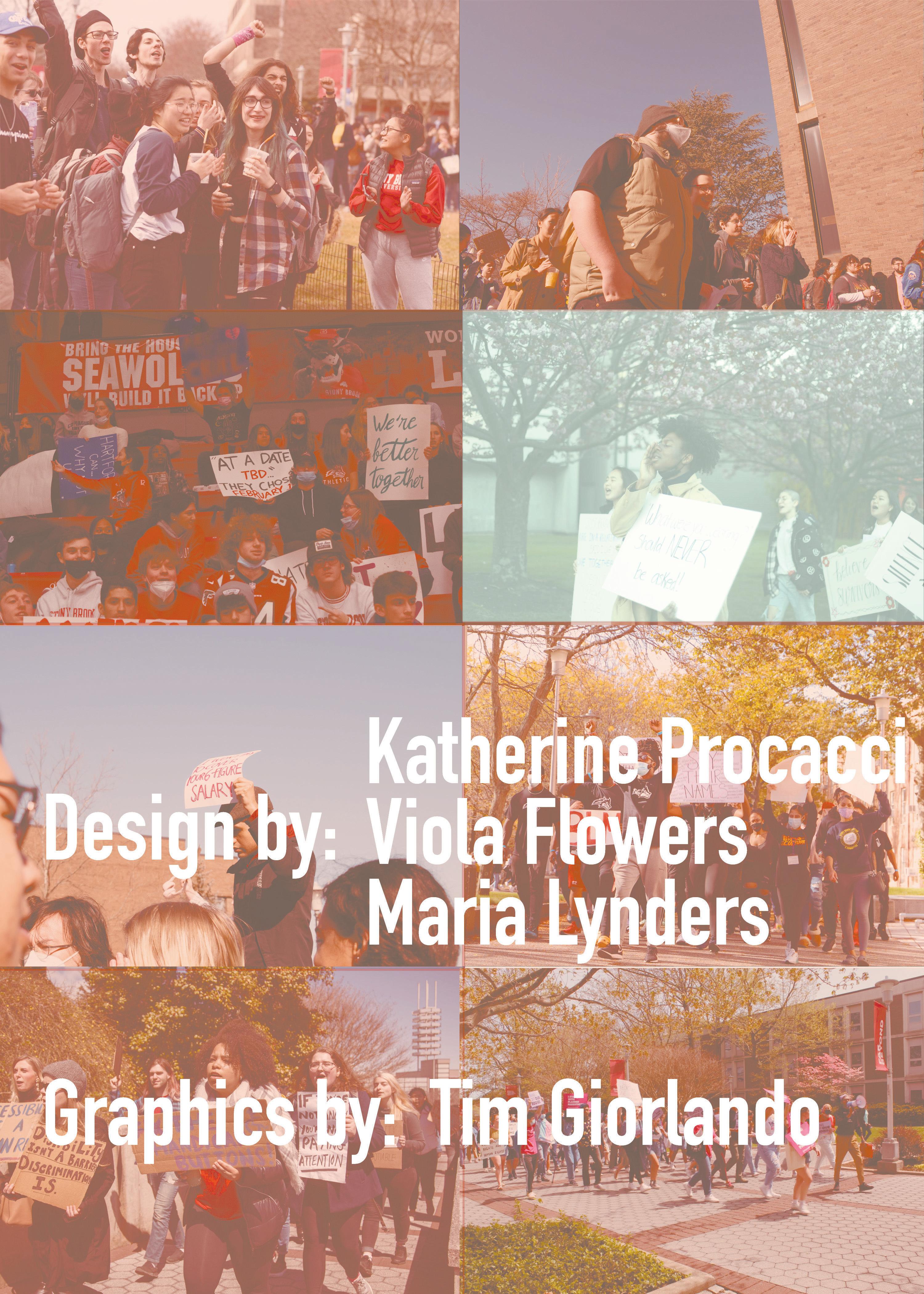










In the 1980s, Howardena Pindell, a Black professor in the Department of Art at Stony Brook University, was the victim of a hate crime in her office on campus.
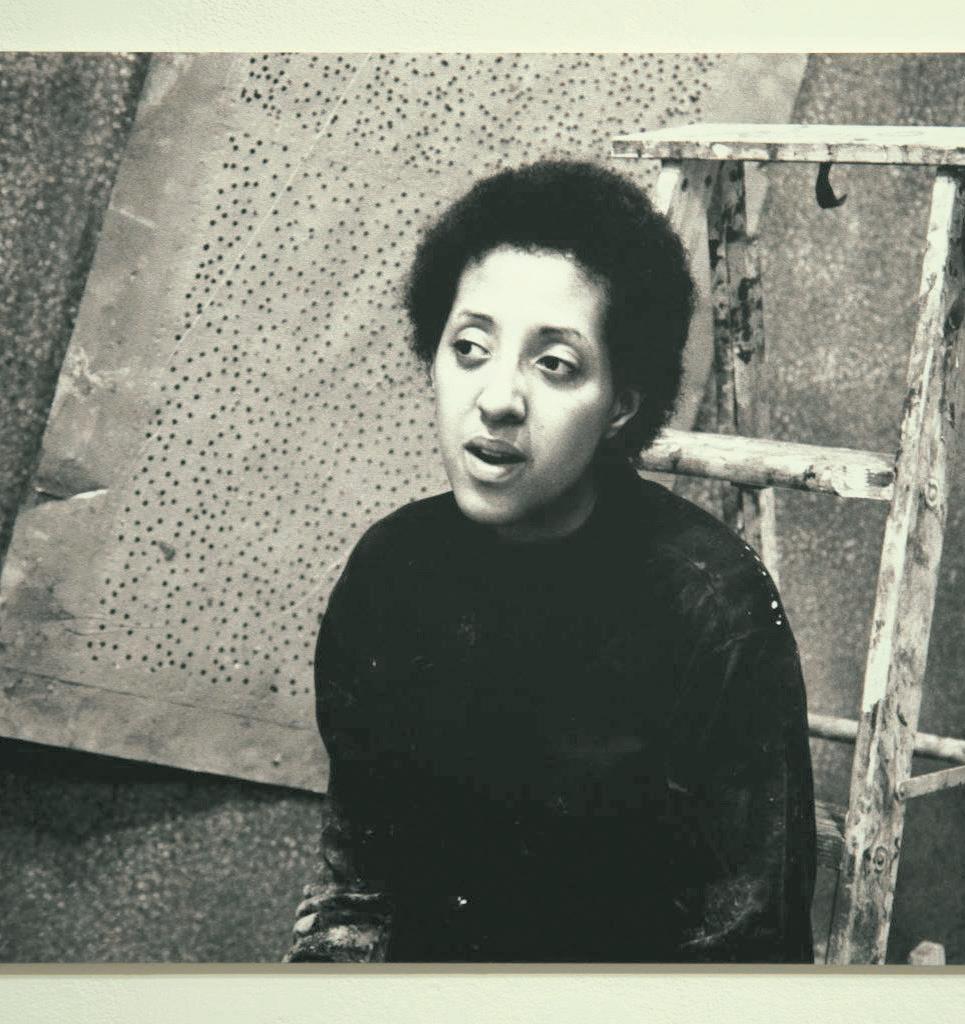
The day after appearing on a television program for WLIW2, Long Island’s PBS Station, Pindell returned back to campus to find black paint thrown across her door by students. They also poured acid under the door of the office next to hers, one that belonged to a Jewish professor.
Recent incidents of racism and antisemitism on Stony Brook’s campus demonstrate that Pindell’s experience is still relevant today.
“When I first joined the faculty, the racism of the students was pretty intense,” Pindell said. “I remember that some of the Black male students were afraid of the white male students and the white male students would walk around with a lot of swagger.”
Pindell recounted that she experienced a great deal of hatred from Stony Brook students during her 44 years of teaching, especially after her television program where she discussed racial issues on Long Island.
Pindell said that upon filing a complaint about what had happened to her office door, the University “didn’t do anything, I don’t think they were set up to do anything.”
On Feb. 4, 1982, The Stony Brook Press released an article discussing racism at Stony Brook and in the Undergraduate Student Government. The article mentions how the school was not as diverse as it should have been, and students who were considered a minority on campus had to deal with a large amount of discrimination.
The Statesman could not find any records of student enrollment by race or ethnicity from the 1980s. But, in 1995, 10% of students identified as Black or African American, 18.9% identified as Asian and 49.3% were white.
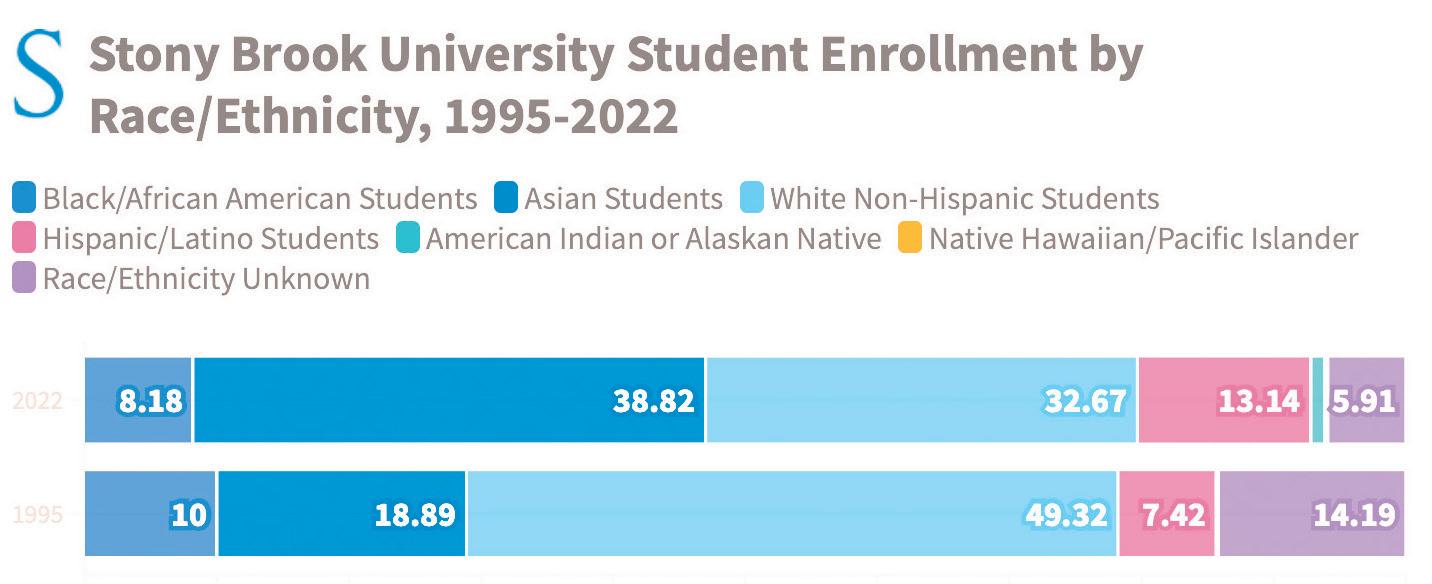
Forty-one years later, students and faculty members are reflecting on whether Stony Brook has changed.
According to Stony Brook’s Fall Headcount Enrollment by Any Indicated Race/Ethnicity, in 2022, less than 10% of students identified as Black or African American and 14.9% were Hispanic or Latino. Most of Stony Brook’s population was either Asian, making up 44.2%, or white, making up 37.2% of the student population.
As a 1977 Stony Brook alumnus, Jonathan Friedman, a lecturer for the honors and undergraduate colleges, feels that the University makes a continuous effort to be as diverse as possible.
“The administration really puts an emphasis on diversity, they really try hard to recruit a diverse class of students and hire a diverse group of faculty members,” Friedman said. “So you get the best of both worlds.”
Pindell sees the progress herself.
“It’s much more diverse as a campus now,” Pindell said. “I see students are friendly with each other. You didn’t really see that much before early on.”
Sydney Bush, a senior sociology major with a minor in Africana studies, disagrees.
“Racism here is not an individual experience at all. [It] isn’t a one time thing,” Bush said. “[It] is something
that is recurring and ingrained in the culture of Stony Brook University.”
On Feb. 9 of this year, Bush had a verbal altercation with one of her suitemates. Bush said that her suitemate insulted her by saying “the monkey is mad because she can’t get her bananas.” In the past, this phrase was used by white supremacists in order to dehumanize and objectify Black people.
Bush said the University’s response failed to meet her expectations — much like what happened to Pindell in the 1980s.
Unsatisfied with the University, Bush took matters into her own hands. She posted her story on Instagram, and within days received nearly 3,000 likes and over 100 comments.
“It wasn’t until I took to social media that I started receiving an overwhelming amount of administrators contacting me,” she said.
Bush said that she told her residential hall director about the situation, who responded later in the day. After contacting the hall director and posting about the incident online, the suitemate was removed from the suite and an incident report was filed.
“Students are being more proactive with whatever issues they have,” said Vivianne Hung, a senior business management and applied math and statistics major. “In terms of Stony Brook responding
to them, I think they’re not doing as much as they should be doing.”
Friedman feels the opposite.
“I’m pretty confident in saying the school will respond to the needs of the students, whatever those needs are,” he said.
Despite conflicting standpoints on the University’s progress over the past four decades, Pindell recognized the positive changes she has seen with the student body.
“The kids have become nicer as people, and I think partly because the campus is in itself more diversified — so they’re in an environment that now is comfortable — Stony Brook is kind of an oasis of civility,” Pindell said.
An old photograph of professor and artist Howardena Pindell displaying her first exhibition as an assistant professor at Stony Brook University in 1980. TIM GIORLANDO/THE STATESMANAt Stony Brook University, where over 17,000 undergraduate students attend what USA Today ranked as the ninth most diverse college in America, students with unpopular political perspectives feel they cannot openly voice their opinions.
Even the president of College Republicans feels the need to censor her views in academic settings.
Sara Adcock admits to having submitted assignments that aligned with her professors’ beliefs rather than her own out of concern for her grades.
“Regretfully, earlier on, there’s been one or two occasions where I’ve handed in papers I wrote that were in opposition to my personal political beliefs out of worry I wouldn’t receive an adequate grade,” Adcock, a junior health sciences major, said. “Being a student at Stony Brook guarantees being almost explicitly taught and exposed to progressive values.”
According to a 2017 study conducted by the Higher Education Research Institute at the University of California, Los Angeles, 48.3% of college professors across America identify as politically liberal.
In the same study, the 2017 incoming class of college freshmen was surveyed about their political beliefs. These results showed 35.5% of students aligned themselves with liberal or far-left ideology, while
22.2% considered themselves conservative or far right.
“I would say that when it comes to political ideology on campus, it’s definitely on the
the fewer students interested in careers in the public sector lead to less political involvement on campus.
But, there have still been a number of political events on campus. College Socialists president Amanda Basinger, a senior double majoring in applied math and statistics and economics, recalled a time when several clubs joined together in response to Turning Point USA (TPUSA), a right-wing political action group, coming to campus.
On Sept. 12, 2021, TPUSA, the New York Young Republican Club and the Long Island Loud Majority held a protest on Stony Brook’s campus after the State University of New York (SUNY) put a system-wide vaccination mandate on its campuses.
“All of us were kind of frightened by the movement of the far right and the dangerous national organization that TPUSA is,” Basinger said.
When it comes to Stony Brook faculty, although there is no data documenting their political ideologies, employees of the university donated over $55,000 to left-leaning organizations in 2021.
Sowad Karim, president of College Democrats, has taken note of student political trends at Stony Brook.
liberal side of things,” Karim said. “There’s definitely a lot more democrats registered on campus, and there’s certainly a lot more of a progressive kind of perspective.”
Karim theorized that Stony Brook’s STEM-heavy student population may play a role in the lack of political activity on campus. Karim explained that, from his perspective,
In December 2022, former Stony Brook University undergraduate and new physician-scientist, Dr. Farzana Ali, added yet another degree to the growing list of letters behind her name.
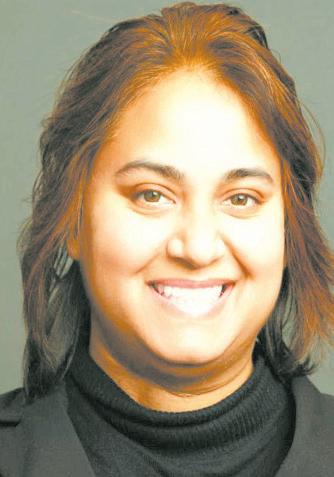
Ali had just finished her Ph.D. in biomedical engineering. She already completed her M.D. at the University of Buffalo and her bachelor’s with Honors, M.S. and M.P.H. degrees from Stony Brook.
For Ali, an international student and a woman of color who uses a wheelchair, the path to finishing her doctorate was neither linear nor traditional.
When she started her undergraduate studies, Ali knew that she wanted to merge her interests in science and math with her desire to work in a humanitarian career, inspiring her to pursue medicine. However, making her goals a reality proved to be a little difficult at first.
“My initial struggles in undergrad were connecting with students,” Ali said. “In the STEM field, most students were males who would hang out in groups, and there were moments when I felt excluded. And for me, it was even more difficult because I came from a different country at that time to pursue my undergraduate education.”
Prior to matriculating at Stony Brook, Ali had grown up in Bangladesh and struggled to adjust to a new environment. She was also on federal work study and was balancing her financial struggles with her academic ones.
“I had the language barrier and I was not very familiar with the culture,” Ali said. “At the same time, being a female in a male-dominated field felt even more overwhelming.”
To compound the culture shock, during her sophomore year, Ali was involved in a motor vehicle accident. Her family’s car was hit by a drunk driver, causing her to suffer a spinal cord injury that left her in a wheelchair.
“On top of everything else, I suddenly had to learn to live in this new body, and then learn to navigate through a world which is not made for people in wheelchairs. I knew I wanted to be a doctor at some point in my career. I just did not know how to go on that path in this newly disabled body.”
According to the National Institutes of Health (NIH), 9% of graduates in the biological and biomedical sciences reported having one or more disabilities. Scientists and engineers with disabilities also have a 2.94% higher unemployment rate than those without disabilities.
In particular, female faculty with disabilities in the STEM fields comprise an understudied, underserved and often invisible population.
But for Ali, her intersectional identity as a disabled woman of color, became a source of strength. From learning how to connect with others and take advantage of the available resources, she developed skills and abilities that not only helped her
grow as a student, but also as a human being.
“As a female, I learned that I should not focus so much on my gender, but what I’m capable of doing, and that’s the sense of strength that actually helped me deal with my disability as well,” Ali said. “Rather than focusing on what distinguishes me or isolates me from the rest of the class, I used it as a strength to connect with others and look beyond what’s isolating, to find something that’s a common experience.”
By developing a stronger sense of self-confidence and pushing herself to connect with others despite the language barrier and concerns about her physical disability, Ali persisted, and eventually thrived, in a predominantly male discipline.
According to the National Library of Medicine, only 3% of medical school applicants in the United States every year apply for M.D./Ph.D. training. After finishing both her M.D. and Ph.D., Ali is currently doing a transitional year in internal medicine as a 2023 match applicant to the Diagnostic Radiology residency.
The Stony Brook College Democrats and the LGBTQS+ Alliance had a meeting with the head of clubs to express their concerns about TPUSA’s campus presence.
“They told us [that] we’re sorry to hear that but we have to protect free speech,” Basinger said. “So our plan of action then shifted to explaining to people what TPUSA does.”
Several counter-protesters appeared at the event, and one person who planned to attend

She was also one of the participants selected by the American Physician Scientists Association to attend the 2022 Introduction to Academic Radiology program.
For Ali, it was her limitations and uniqueness that allowed her to reach these heights. Her experiences taught her to look beyond her limitations and focus on what she is able to do instead of what would prevent her from achieving her full potential.
A headshot photo of Dr. Farzana Ali. PHOTO COURTESY OF FARZANA ALIOceans away from Iran, Stony Brook students are doing their part on campus to raise awareness of the protests happening worldwide following the death of Mahsa Amini in September 2022.

Mahsa Amini was a 22-year-old woman who died after three days of being detained by police for reportedly not following the country’s dress code in September 2022.
Protestors, especially women, are demanding the end of the mandatory hijab law. The Guidance Patrol, or “morality police,” has the authority to arrest or fine individuals violating the Islamic Republic’s dress code.
Stony Brook University’s Iranian student population has banded together to support the movement and spread the protesters’ message.
“We hear their voice, and we are their voice here,” said an Iranian Ph.D. student who has asked to remain anonymous out of safety concerns.
The Iranian Graduate Student Association has played an active role in Stony Brook University’s advocacy for Iran since the start of the uprisings. The association’s main goal is to raise awareness and show support for the people of Iran.
Stony Brook joined over 200 college vcampuses around the world that have participated in demonstrations to protest the actions of the Islamic Republic. On Nov. 30, 2022, the Iranian Graduate Student Organization held a demonstration in the Student Union.
Members of the Iranian Student Association participated in the movement by cutting off some of their own hair at the demonstration. Hair-cutting has become a prevalent act of protest as a way to challenge the standards set by the Islamic Republic.
“It’s a symbol of feminism,” said Zavosh Mottadesh, a Ph.D. student in computer science and president of the Iranian Graduate Student Association.
Attendees also dipped their hands in red paint and pressed them on a banner to symbolize the loss and bloodshed of Iranian protesters.
As described by the unnamed Ph.D. student, a key component of protests is to encourage Americans to “raise awareness [and] talk about this … so that more people know what’s happening.”
Members of the Iranian Graduate Student Association informed audiences of the killing of innocent Iranians, while also playing videos that displayed the international protests in solidarity.
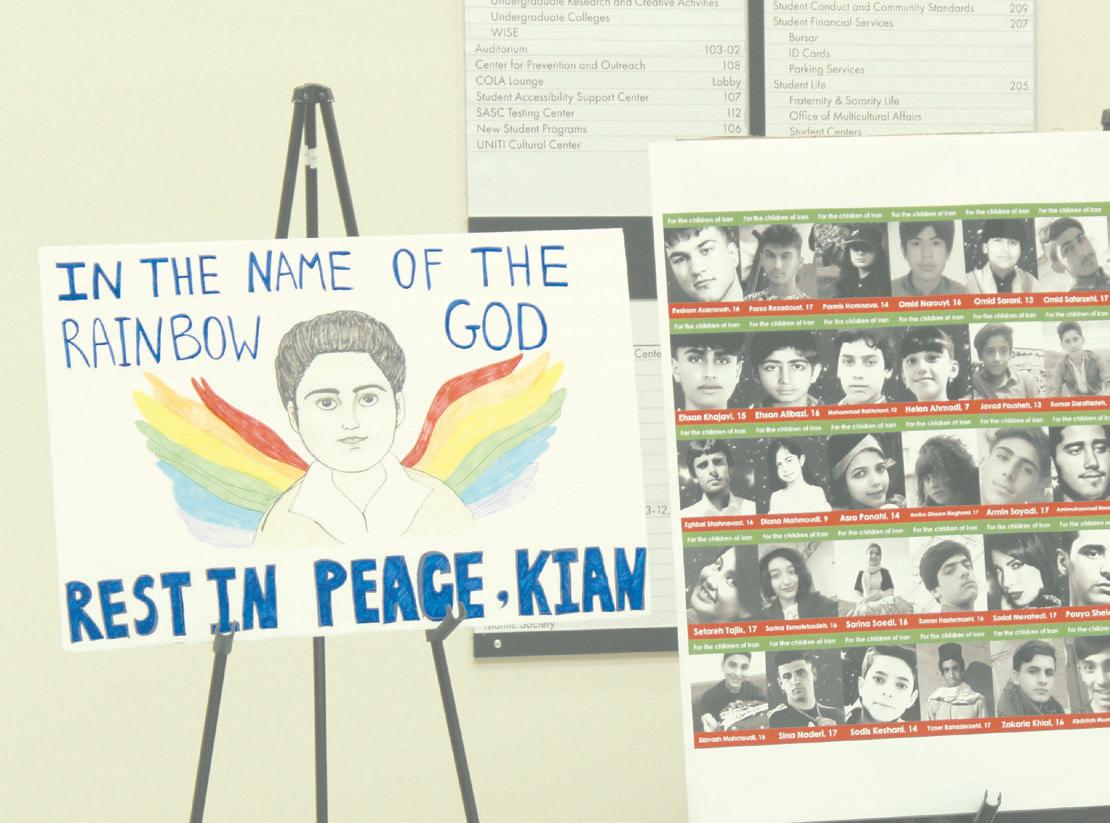
Additionally, students sang Iranian protest music at the event. The motifs of these songs were female empowerment and resilience.
“We are trying to spread the word internationally,” Mottadesh said.
Over 500 protesters have been killed in Iran since September 2022. Over 19,600 people have been detained.
“Not only do I hope, but I believe and want conditions in Iran to get better,” Mahan Agha-Zahedi, a Ph.D. student in electrical engineering, said. “The only way for that to happen is to overthrow the government. I doubt that the government officials will resign.”
The Iranian peoples’ relationship with their government also became a topic of discussion during the World Cup in November and December 2022.
The Iranian soccer team’s captain, Ehsan Hajsafi, publicly supported protestors and ex-
pressed alignment with the Iranian people over the government.
“We have to accept that the situation in our country is not good and that our people are not happy, they are discontent,”
Hajsafi said at a press conference. “We are here, but it does not mean we should not be their voice or that we should not respect them. Whatever we have is theirs.”
Although Stony Brook students may agree with Hajsafi’s statement, they have conflicted opinions about the Iranian soccer team’s overall involvement in the competition.
“In Iran, sport is very much involved with politics, and the government has a significant control over sport,” Mottadesh said. “Iranian people within and outside of Iran requested FIFA to ban the Iranian national soccer team from the World Cup, but FIFA didn’t care.”
When Iran’s team faced Wales, they did not sing their national anthem in an act of protest, which resulted in negative attention from the Iranian government. But, the sentiment remains that no specific effort can definitively end the horrifying circumstances in Iran.
“Nobody can predict anything, but I believe it’s going to be better someday either in this generation or the next,” Mottadesh
said. “Unfortunately, nobody knows when conditions in Iran will get better.”
President Raisi publicly blamed all of the unrest in Iran on Western influence during a televised speech on Feb. 11. While this speech was being streamed online, a hacker group interrupted for several seconds before the regular feed was restored.
A masked woman appeared on screen. With an altered voice, she called for the continuation of protests against the Islamic Republic.
But the unknown does not stop the Iranian Graduate Student Association from advocating for the people in Iran. The devastation arising from death and injustice is still felt, and it pushes students to continue showing their support.
“I feel like I’m losing a friend every day,” the anonymous student said. “I’m mourning people I don’t even know every day.”
Signs held up at a demonstration by the Iranian Graduate Student Association on Nov. 30, 2022. COURTESY OF THE IRANIAN GRADUATE STUDENT ASSOCIATION“I became more cognizant of the need for a healthy life to ultimately pursue my goals,” Ali said. “I also realized that I can do it at my own pace. I don’t have to follow the timeline that society has placed on me.”
Ali is referring to the “traditional” path that many students take, both to a career in medicine and through higher education, where they apply to graduate programs directly after they finish their undergraduate degrees.
Many stigmas persist against non-traditional students who don’t follow this path. Oftentimes they are older, career-changers, or simply apply to graduate programs later in life. However, many medical schools are currently working to better embrace new aspects of diversity by recognizing the benefits of non-traditional career paths.
Ali’s disability made it harder for her to follow a linear path to her medical and doctorate degrees. When she initially came back from the hospital, she took her time to retrain her body to adapt to its environment, both academically and at home. She also spent time relearning the resources that were available to her. This included seeking support from professors, TAs, the pre-health offices, etc.
“I felt like I came out as a more balanced person who valued relationships more after
my injury. And thankfully, gradually I was able to go to med school and finish my studies,” Ali said.
Throughout the whole process, Ali learned how important it was for her to draw strength from the connections she had, and how to keep herself healthy, both mentally and physically.
“Those are the things that will keep you alive when life gets really difficult, and it gets harder to move on,” she said.
Ali also benefitted extensively from female mentorship through her undergraduate and graduate studies. She aims to become a role model for more girls in the future.
By serving as a teaching assistant at Stony Brook, she was able to connect with high school, undergraduate and graduate students
in engineering and pre-health fields. The small number of female students in her classes are what made her more aware of the need for females in computer science and engineering.
“I also realized that I was fortunate to have a mentor from the field of electrical engineering, where the female representation is also comparatively low,”
Ali said, referring to her Ph.D. dissertation advisor, Christine DeLorenzo, with whom she connected while she was an undergraduate.
Ali’s connections with her mentors largely inspired her path.
“Those connections were so strong I do not want to let go of that just for my career
aspirations,” Ali said. “And I have learned in my academic journey, that the most important parts are the people and the connections that I made. So even if I had to take a detour in my path, to stay close to those connections, I happily did that.”
Instead of pursuing a traditional M.D./ Ph.D. degree, she wanted to stay in the lab where she completed her master’s degrees and pursue her medical education at an institution that was more accommodating of her disability.
For Ali, the University of Buffalo had the financial resources and the personnel to meet those needs. After graduating, she then came back to Stony Brook, where her dissertation focused on the application of machine-learning techniques for the prediction of antidepressant treatment response.
In the future, Ali strives to pursue academic medicine, where she can teach the next generation of physicians and biomedical engineers and serve the patient community.
“It’s up to us females who are currently in the field to encourage the next generation and help them see how many opportunities there are, and pave the path for them,” Ali said. Like it was done for us.”
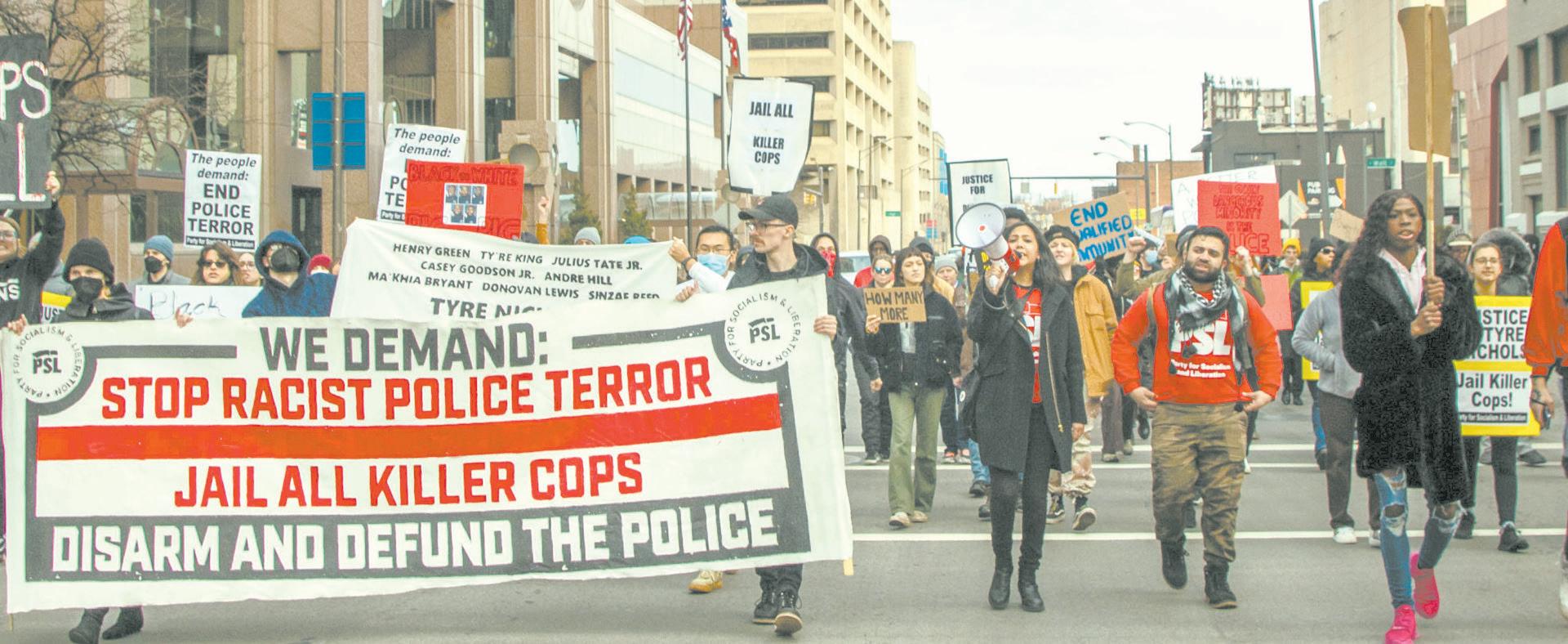 By Katherine Moquete
By Katherine Moquete
Content warning: sexual violence
Tyre Nichols, a 29-year-old Black man, was threatened, pepper sprayed, tased and brutally beaten by five Memphis police officers on the evening of Jan. 7.
The sounds of Nichols begging, pleading and crying for his mother were ignored. He lay on the pavement bleeding, just 100 yards away from home.
This came after officers pulled Nichols over for a traffic stop following alleged “reckless driving.”
Officers immediately used excessive force for the entirety of their encounter with Nichols despite him exhibiting no dangerous behavior. Following the vicious abuse and violation of his rights, Nichols passed away at St. Francis Hospital on Jan. 10 — his face so horribly battered he was unrecognizable to loved ones.
There are countless instances of police brutality throughout American history but, in the last 10 years, there has been increased attention toward police violence. The response to the killings of Trayvon Martin, George Floyd, Breonna Taylor and Eric Garner all exemplify this.
Yet, coverage of these victims will often fixate on alleged criminal pasts or decry them as “no angel” without placing blame on police officers.
The biggest question is: why is the public perception of police brutality focused on the “violent” offender rather than the police officers responsible?
Let us go back to the United States in the 1990s — a country plagued by crack cocaine, violent crimes and major police reform.
During this era, two FBI agents began to investigate and conduct interviews for a study they titled “Killed in the Line of Duty.”
One leader of the study had experience as a police lieutenant, and the other was a Catholic priest with a doctorate in psychology.
In addition to this, the study reiterated that the behavior of an offender is what makes an encounter aggressive.
Police violence with minimal provocation is also apparent in the 2014 murder of Eric Garner who displayed no violent nature. Despite his nonviolent crime, Garner was placed in an illegal chokehold and arrested in an aggressive manner that turned fatal.
BY BECKER1999/CC BYThey decided to analyze the motives behind the actions of convicted police murders.
Over three years, the duo interviewed 50 offenders that were responsible for the deaths of 54 police officers. The leaders of the study investigated what characteristics the murdered police officers shared, in addition to the psychological health of the offender.
The study garnered national acclaim and was even featured on the front page of The New York Times. As a world-renowned news outlet, the impact of their words can heavily sway the minds of those who read to inform themselves on race and politics. The 1992 study’s prestige, doubtlessly boosted by The Times, has made it a lasting and influential document in policing.
The study’s conclusion showed that police officers killed in the line of duty by those interviewed were “good-natured” and overall friendly individuals who used little to no force with offenders. The officers’ amiable behaviors made them well-liked in their communities, as well as in their departments.
While the study had no ill intent, it unintentionally informed modern understanding of police brutality.
This interpretation soon reached the ears of police departments nationally. Some analysts have suggested that it led to a change in officers’ mindsets, treating all perceived offenders as threats to their safety.
Officers arguably then started to treat all offenders they encountered as potential threats to their safety. The instilling of a “dominate-or-die” notion amongst police is still prevalent today and is heavily exhibited by the killing of Tyre Nichols.
“Don’t move,” followed by “Give me your hands” and “Lie flat, goddamnit,” were some of the conflicting commands barked by the five Memphis police officers who detained Nichols. “Defying” their orders was interpreted as a rebellion and as an unjust result. Force was used on Nichols despite bodycam footage showing no grounds for violence.
We need to stop extrapolating the study’s findings to deaths like Tyre Nichols’, which do not involve violence against police officers.
This is also apparent in the 1997 case of Abner Louima, who was arrested at a nightclub after a physical altercation with another partygoer. He was accused of allegedly “attacking a police officer” and resisting arrest, both of which were later proven false in court. He was beaten, strip-searched and raped with a broomstick before being dumped at Coney Island Hospital by police officers claiming to have found him partaking in “abnormal homosexual activity.”
Later in court, the officers involved admitted they did not feel threatened by Louima.
Despite the public’s introduction to Nichols in this tragic manner, we must not brand him solely as a victim. We must not brand any of those murdered at the hands of police only as victims. They were all individuals who led meaningful lives, accomplished goals, had hopes and dreams and left their marks on loved ones. Tyre Nichols was a father, an aspiring photographer and a son.
The way to honor his legacy is to appreciate his work, give his family time to grieve and spread awareness of police brutality so we will never have to hear another narrative of this injustice.
In order to avoid the harm the study perpetuated, the country needs education regarding police brutality, police culture, racism and privilege. Choosing to ignore the issue at hand and to not educate yourself on your own privilege makes you a contributor to the problem. Say his name and do not forget him: Tyre Nichols.
“As a female, I learned that I should not focus so much on my gender, but what I’m capable of doing. And that’s the sense of strength that actually helped me deal with my disability as well.”
-Dr. Farzana Ali
With Black World’s first printed issue in 10 years scheduled to be released soon, the publication is renewing its mission to represent the voices of Black and Latino students on campus. The printed newspaper coming out at the end of February aims to distinguish itself from other Stony Brook University media organizations.
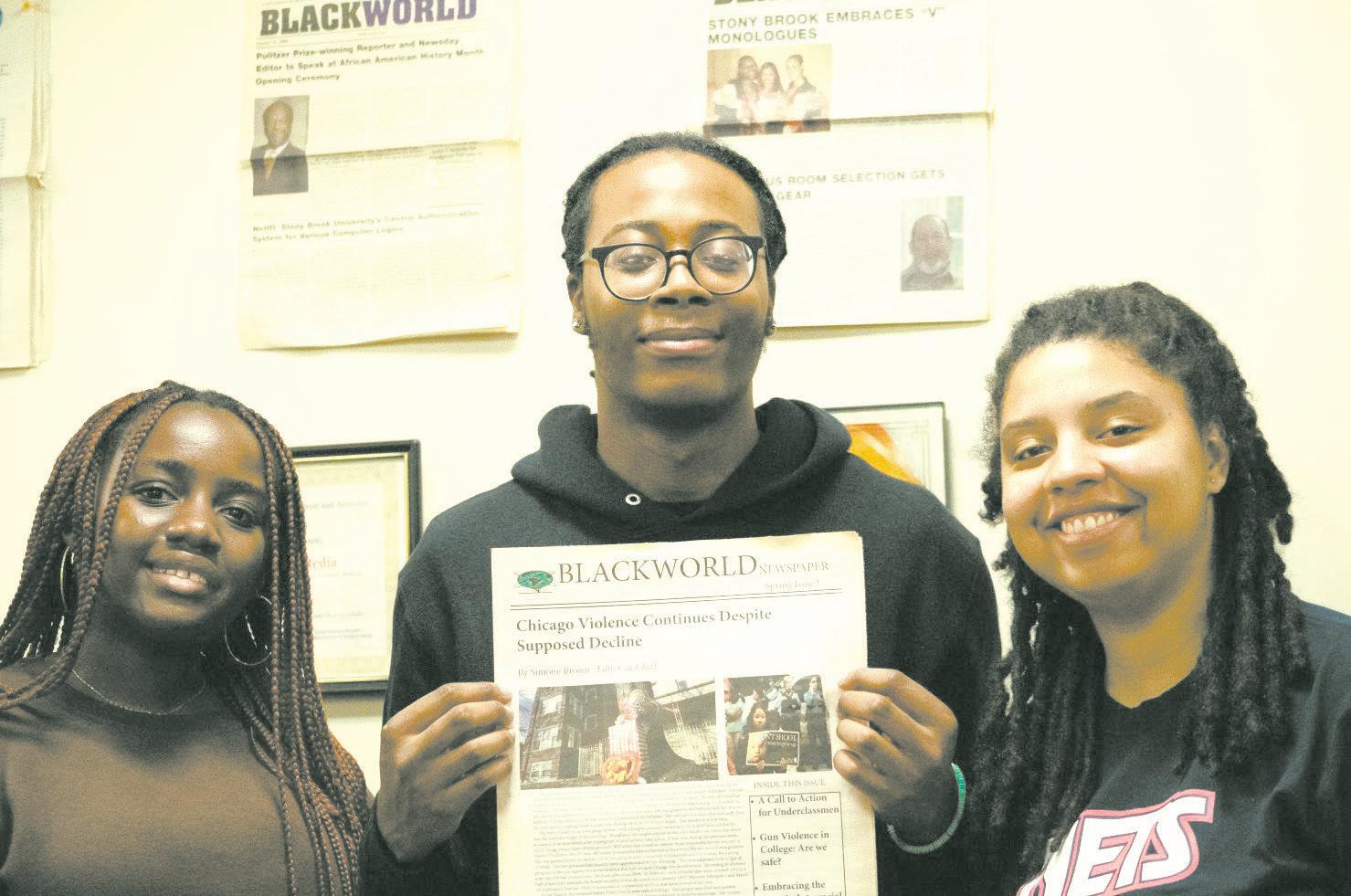
“Black World is a media organization where we try to highlight Latino and Black students on this campus,” said Black World lead writer Audrey Fernandez, a senior majoring in biology and minoring in Africana Studies.
Founded in 1974, Black World primarily served as a core aspect of activism on campus, as well as a means for Black and Hispanic students to report on news from their perspectives.
A 1979 edition of a Black World publication, for example, features a variety of articles surrounding student life, from sports to rallies covered with “the black perspective in mind.”
Now, Fernandez and the rest of Black World aim to continue extending their impact, serving Stony Brook’s Black and Latino communities through print publications, multimedia content, general body meetings and events.
“The vision for Black World [is to] be the proving grounds for young Black creatives on this campus,” said Oluwatunmise Akinfeleye, a junior political science and journalism major and Black World vice president.
Black World took a hiatus from 2013 to 2018. Fernandez was told this break was due to a lack of USG funding. When the organization came back to life, Fernandez said that COVID-19 made it difficult for continuity, making the upcoming publication of the Black History Month special issue especially meaningful.
“2022 was the year [Black World] basically started rising back up, and then I feel like the publication kind of set in stone,” Fernandez said. “It really kicked it off into the momentum of Black World.”
Aside from publishing articles and creative writing, Black World serves as a comforting environment for students.
“It’s just nice to be around creative people, creative people who care about the things I

care about,” said Meloseri Dumnoi, a video editor and freshman majoring in
it gets scary because it’s not as if what you’re saying is wrong, but people around you might not relate to your experience.”
The concept of a shared experience is one of Black World’s main priorities. Black World is Stony Brook’s only media organization focused on and catered to the Black and Latino community.
“What better way than learning through us, instead of hearing from others,” Fernandez said. “Yeah, we could be part of The Press or The Statesman and write an article, but it’s not the same as an entire [publication] being by students of color and for students of color.”
Fernandez’s statement alluded to a section of The Statesman called “Black Voice” that was active for some time during the 1960s. She described the section as “before Black World was Black World.”
economics, globalization studies and international relations.
Dumnoi said joining Black World as a freshman significantly eased her transition into college. She described the organization as a safe space for people to express themselves.
“I think it’s a nice place to come and just talk about the things you want to talk about,” Dumnoi said. “Sometimes in class, you want to say something you want to add, but sometimes
The special issue is expected to be in circulation by the end of the month. Black World will be hosting a launch party on Feb. 25 in the United Nationalities in the Transcending Ideologies (UNITI) Cultural Center.
The organization evidently has aspirations beyond being yet another campus publication. They strive to make a mark on the University and beyond.
“I want it to be a place where years down the line, we can have notable alumni like ‘Oh, yeah, started at Black World,’” Akinfeleye said.
Editor-in-Chief.................Jeremy Portnoy
Managing Editor.......Katherine Procacci
Managing Editor.................Viola Flowers
Managing Editor...............Maria Lynders
News Editor....................................Lori Saxena
Sports Editor............................Mike Anderson
Opinions Editor.....................Christine Kelley
Multimedia Editor...................Tim Giorlando
Copy Chief......................................Skylar Sena
Audience Engagement...............Alissa Pabon
Asst. News Editor....................Sonya Gugliara
Asst. Arts & Culture Editor.........Jenna Zaza
Asst. Sports Editor......................Matt Howlin
Asst. Sports Editor..................Kenny Spurrell
Asst. Opinions Editor...........Anya Marquardt
Asst. Opinions Editor..................Sara McGiff
Asst. Multimedia Editor.........Brittney Dietz
Asst. Multimedia Editor..........Camron Wang
Asst. Copy Editor..........................Olivia Erndl
Asst. Copy Editor..................Alyssa Pascocello
Asst. Audience Engagement..McKenzie Post

To contact the Editor-in-Chief and Managing Editors about organizational comments, questions, suggestions, corrections or photo permission, email editors@sbstatesman.com.

The Statesman is a student-run, student-written incorporated publication at Stony Brook University in New York. The paper was founded as The Sucolian in 1957 at Oyster Bay, the original site of Stony Brook University. In 1975, The Statesman was incorporated as a not-for-profit, student-run organization. Its editorial board, writers and multimedia staff are all student volunteers.
The Statesman and its editors have won several awards for student journalism and several past editors have gone on to enjoy distinguished careers in the field of journalism.
Disclaimer: Views expressed in columns or in the Letters and Opinions section are those of the author and not necessarily those of The Statesman.
For more Statesman content, visit us at sbstatesman.com and follow us on Twitter and Instagram @sbstatesman.
At Stony Brook University, organizations for underrepresented communities are an important part of student life.
Stony Brook’s campus now hosts over 70 clubs that provide an established community to students of different backgrounds. The Afghan Student Organization, the Caribbean Student Organization and the Sikh Student Association are just a few examples.
Ethnic organizations are widely considered some of the most important student clubs. They provide environments that allow for connections between students who share a cultural identity.
Cultural groups help forge communities on campus. They also act as educational resources to inform the student body about other cultures.
“All of these people share a heritage and we can just all gather into one place,” David Gonzalez, a freshman representative for the Latin American Student Organization (LASO), said. “They can come and gather with their friends … share music, share their life events, things that they are going through … that is very important in terms of a supportive aspect of being a community.”
Efforts towards ensuring inclusion for all students are a primary goal for Stony Brook.
The University’s Diversity Plan states that “there have been various efforts in the past, along with current work being done, to improve the campus climate and to make headway in meeting the goal of developing a more inclusive community at Stony Brook.”
Student organizations also play an integral part in the goal by holding events to educate and celebrate their respective cultures.
LASO in particular hosted events like Café Con Laso, a Day of the Dead Celebration and conversations on Colorism in Latin America. They also participated in the 30th Annual Opening Ceremony Celebration in 2019, which celebrated both the start of Hispanic Heritage Month and 30 years of Hispanic excellence at Stony Brook.
Organizations such as LASO can also benefit students who are not a part of the Hispanic or Latino community or have had little interaction with those cultures beforehand.
“Attending LASO would be a good way to open your eyes, because
obviously Latin America may not have anything to do with your culture, but you can share in celebration and you can also participate and become more aware of the different cultures around you,” Gonzalez said.
The impact that LASO and similar cultural organizations can have on campus is well understood and emphasized by its members.
Even students who haven’t attended events offered by cultural organizations can see the impact on campus.
“When I think of anti-racism resources, I mainly think of clubs like the Asian Students Alliance,” Reem Hamdan, a freshman biology major, said.
Hamdan also finds that cultural clubs help connect people to their culture. He has experienced this firsthand as a member of the Arab Language and Culture Club.
“It helps in knowing you have that community on campus,” he said.
Increasing diversity and an understanding of these communities is an ongoing effort.
For organizations such as LASO, raising awareness on issues specific to the Latino community is an important goal. Gonzalez noted that Latinos of various backgrounds are treated differently within the community.
“We’re not homogenous, but that doesn’t mean that you get to treat anyone differently just for their nationality,” Gonzalez said. “It’s also a matter of teaching that to others, teaching that to ourselves … which in a lot of ways does involve combating racism and forms of colorism.”
Despite the importance of these organizations, not all students are aware of them, which prevents them from taking part in their events or joining.
Anish Shenoy, a freshman psychology major, has not attended events from cultural organizations but said that he would if he was more informed. Another freshman, biology major Alina George, also sees the value of cultural groups.
“I think it’s really important that people have a place to go where they’re surrounded by similar people who understand them,” George said. “So I think these organizations have had a great impact on making people feel seen and heard.”
the event said on social media that they would be armed in case of any “leftist counter protesters.”
The event highlighted political tensions on campus and sparked a petition to ban TPUSA from campus, which ultimately failed. The chapter was then approved as a legitimate campus organization, but now no longer appears on the SB Engaged platform, signifying it is most likely inactive or no longer has university approval.
Adcock expressed that she feels Stony Brook has a liberal ideology extending beyond student-led organizations.
“I’ve experienced very little political diversity in the curriculum at Stony Brook,” Adcock wrote in an email to The Statesman. “I’ve taken many classes here that have left-leaning messages woven into the course material.”
A popular college ranking website even ranked Stony Brook as the No. 12 most liberal college in the country. Adcock agrees with this, pointing out that many conservative students on Stony Brook’s campus often feel silenced and ignored, based on her experiences.
She also expressed frustration with student organizations on campus, feeling that many of them are left-leaning. This includes the Undergraduate Student Government (USG), which Karim is the president of.
However, leaders of different Stony Brook political organizations agreed that students tend to treat each other with respect on campus when discussing differences in political beliefs.
C.J. Burgardt, secretary of the College Democrats, said that while students tend to act civil to each other on campus, it can be a different story in online spaces.
“I think it’s because it’s on an online platform, people are more confident, and calling out other people,” Burgardt said. “And this isn’t just for politics, just about things that happen on campus in general.”
Despite what happens online or in the classroom, Adcock advised students with minority views to not be afraid of having different opinions than their peers.
“When I was an incoming freshman at SBU, it was a bit daunting entering a university known for being so liberal,” Adcock said. “As I discovered for myself, there are many more like-minded people out there than you might initially think. Some of my closest and strongest friendships are those I’ve made by getting to know politically similar peers in College Republicans.”
